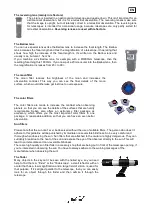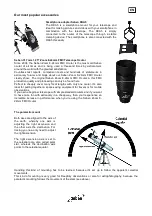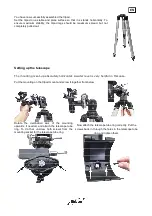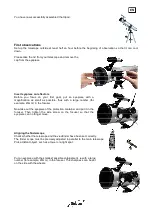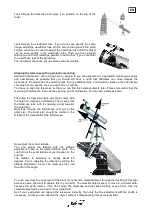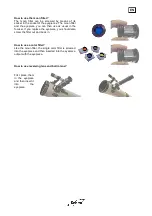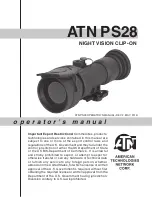
EN
The reflecting telescope:
You look into a reflecting telescope at the side. Reflecting telescopes are also called “reflectors”, because
they reflect the light (Latin “reflectare”=reflecting). The light falls through the frontal opening onto the big main
mirror. It reflects the light onto the small secondary mirror, which is located in the tube called “lens barrel”.
From there the light falls through the “ocular” into the eye.
Optics
Magnification
The size of a telescope is determined by the opening and the focal length. The opening is the diameter of the
objective lens or the main mirror and the focal length is the distance of the objective lens or the main mirror
to the focal point. The magnification can be change as desired through oculars with different focal lengths.
Here an example:
Telescope Seben 1000/114 > opening 114mm, focal length 1000 > magnification with a 10mm ocular
1000/10 = 100x
Light-gathering power
The light-gathering power is dependent on the diameter of the objective or the lens of the telescope. Simply
put: the bigger the diameter, the higher the light-gathering power. It increased squarely with the diameter.
The light-gathering power of the telescope is calculated like this: Opening² in mm² / 49
Example: Opening 114mm > light-gathering power 265 (calculation: 114² / 49 = 265)
Resolution
The resolution capability increases linearly with the size of the optical diameter and it makes it possible to
see things more detailed. The resolution capability is calculated like this: 138 / opening in mm
Example: Opening 114mm > 138 / 114 = 1,2“
Accessories for telescopes
Please note that this is a general information and that the mentioned accessories are not included in
the delivery of the telescope that you bought.
The ocular
A telescope is a tube with lenses or mirrors inside. It collects the light and
sends it out again through an opening The opening is also called “focuser”.
If you look into the opening without an ocular then you won’t see a sharp
image. It’s the ocular that collects and magnifies the light as a lens onto a
point of the retina in the eye. There is usually a number on the oculars.
The higher the number the less it magnifies the section of the image.
The ocular is put into the focuser. When you change the ocular you’ll see that the picture won’t be sharp
anymore with the new ocular. Every ocular has a different “focal point”, so it collects the light on a different
point than the last ocular. So it’s best to adjust the image and make it sharp again with every change of the
ocular. Use the wheels on the side to move the focuser in and out. Always start with the smallest
magnification. Take your time when you observe. You have to learn first how to observe with a telescope.
The diagonal (only for refractors)
The picture is upside down and inverted in astronomical
telescopes. The star diagonal is righting the picture again, so
that you can also comfortably make nature observations, but it
doesn’t correct the inverted image. It deflects the optical path by
90 degrees, so that it’s easier to observe objects near the zenith
through the ocular.
The Amici prism corrects both, so it rights the picture again by 180 degrees. Amici prisms are available with
a 90 degree and 45 degree deflection. Prisms are put into the focuser before the ocular.
Prisms are only used in refractors.




